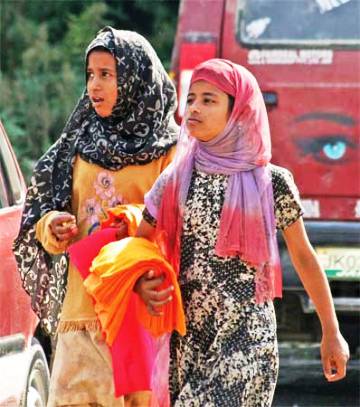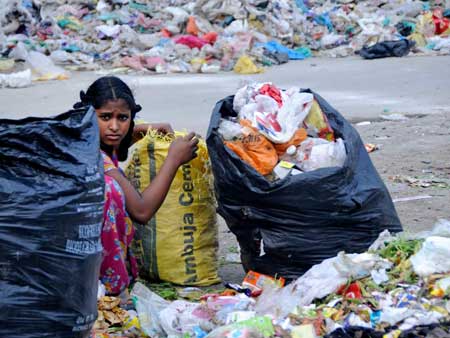Working, earning a livelihood for siblings and a homemaker mother sounds so noble. But a 16-year-old doing all that is no mean feat. Irfan had a comfortable life until their parents divorced two years back. Irfan, his mother and his three siblings were left with no source of income. Being the eldest among the siblings, Irfan took the responsibility of feeding and providing for the family.
He quit his studies and started working as a bus conductor. Earning Rs 150 to 200 a day, he fed his family besides taking care of the schooling of his two brothers and a sister. Besides, the cute boy saved Rs 15 each day for one year from his meagre earnings so that he could pay the fee for appearing in the matriculation exam.
“I will be applying as a private candidate,” says Irfan. He studies in the evening and takes help from friends when needed.
“During the day I go by bus. And while late hours I study. I will bear whatever I have to for my education,” says Irfan.
Irfan is a rare case among the child labourers, who can afford the luxury of hope and optimism, for most, almost all working children it is a dead-end, says aid worker Jalil Lone.
Officials say there are 175,000 child labourers in Jammu and Kashmir. However, independent surveys put the number of child labourers at around 250,000.
Researcher Fayaz Ahmad Nikka in his recently published book Child Labour In Jammu And Kashmir claim that There are around 2.40 lakh child labourers in Jammu and Kashmir.
Though various researchers have attributed different reasons for the menace of child labour, most of them hold poverty as the main culprit. “Poverty is one of the major reasons for child labour in Kashmir. Parents are compelled to send their children to work as they are unable to feed their families,” says researcher Saima Hamid, who has worked on projects related to children.
Sociologist Bashir Ahmad Dabla says, “Insufficient income in families forces children to work for a living.”
A recent state government survey claims that one-fifth of the state’s population falls below the poverty line. It says that there are 24.21 lakh (22 lakh from rural and 2.21 lakh from urban areas) persons falling below the poverty line.
“My father is a labourer. He earns some Rs200-Rs250 a day. We have a seven-member family. So quit my studies to help my family,” says Rouf Sheikh, 14, who works a sweeper early morning and later in the day as a cobbler. He quit studies three years ago when he studied in the fifth standard.
“Poverty dragged me into this situation. When my father was not able to bear family expenses my conscience did not allow me do nothing,” he said. Sheikh gives his Rs 1500 a month. “I have to help my father to marry off my sisters.”
Child labour are everywhere in Kashmir – in automobile workshops, as bus conductors, rag pickers, waiters, salesman in shops, manual labour, farmworkers and in the handicrafts sector.
Dabla says, “The quest of finding a job in children, and need of cheap labour for the employer is both responsible for their working at these places.”
In her research Saima has found other factors also, she says, “Since they (working children) do not have any skills, they prefer doing what they are capable of especially manual labour.”
Barely 13 years old one child working at a car mechanic shop said: “I am sixth standard pass, what job can I do better than this.”
Kashmir’s handicrafts industry, which has long served as the backbone of the state economy, has the dubious distinction of being the state’s leading employer of child labourers.
Saima says that the shawl industry was a particularly ravenous employer of children, especially young girls, whose small hands are useful for the intricate work of shawl making.
“Basically, parents take credit from us and then make their children to work to pay off the debt,” an owner of shawl weaving house pleading anonymity told Kashmir Life.
When asked why he allows these children to work at his establishments, he said, “Their parents plead with us for employing these children for the reason of being very poor. So we are left no option but to let them work here.”
Interestingly, when this reporter was talking to him, the mother of one of the child worker came for taking his son’s monthly stipend. On being asked for the reasons for making his child work, she said, “I am a widow. I have three daughters back at home. I work as a peon in a local private school. How much can I afford from that meagre amount.” The tears rolling down her tired face left no scope for any further question.
The government, sociologists say, does not have any practical policies or approach to tackle the issue of child labour.
Dabla alleges that the government’s policy of putting a blanket ban on child labour is not helping in curbing the menace. “Banning is not sufficient to stop it; instead it adds (to the problem). As after forcibly stopping them, they are left with no alternative but to earn but through unlawful activities,” he says. “Government needs to provide them skill-based education and not stop them from earning as they belong to poor families.”

















